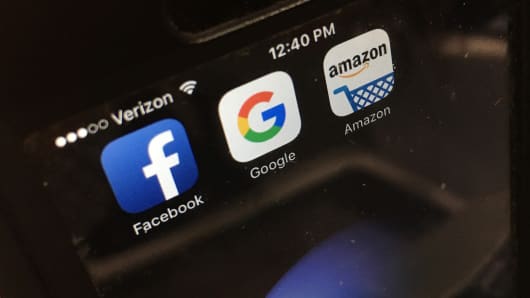Last night I swiped myself out of the parking garage, used WAZE to avoid the Fenway Park pre-game crowd, removed the puppy's electronic-fence collar before we went for a walk and streamed a crazily violent Netflix show after dinner. While I watched the episode, I used both my Amazon Prime and PayPal accounts to make a couple of online purchases. To which of these activities does the word "technology" not apply?
I am no digital geek, but I live my life the way everyone does — surrounded by technology. That is why I am surprised and frustrated that so many smart people have been warning that the technology sector's weight in the S&P is dangerously high.
At almost 25 percent, that weight is second only to the 29 percent peak level tech held during the internet bubble in 1999 and 2000. However, I would argue that there are significant reasons to believe the weight today is fully justified, or even understated when considering the economic impact of technology.
Just comparing the top 10 stocks in the tech sector in 1999 and now sheds light on key distinctions.
| S&P 500 Weights Over Time (Sectors) | ||||||
| 1999(1) | 2007(2) | 1Q18(2) | ||||
| Sector | Weight | Weight | Weight | |||
| Consumer Discretionary | 12.70 | 8.18 | 13.08 | |||
| Consumer Staples | 7.17 | 10.42 | 7.66 | |||
| Energy | 5.55 | 12.73 | 5.75 | |||
| Financials | 13.02 | 18.08 | 14.76 | |||
| Health Care | 9.31 | 12.39 | 13.64 | |||
| Industrials | 9.91 | 11.55 | 10.29 | |||
| Information Technology | 29.18 | 15.85 | 24.45 | |||
| Materials | 3.00 | 3.42 | 2.85 | |||
| Real Estate(3) | 0.00 | 0.00 | 2.76 | |||
| Telecommunication Services | 7.94 | 3.53 | 1.91 | |||
| Utilities | 2.21 | 3.87 | 2.85 | |||
| 100.00 | 100.00 | 100.00 | ||||
| Source: FactSet | ||||||
| (1)Data from 1999 uses S&P 500 weights. | ||||||
The earlier period was dominated by firms like Microsoft, Cisco, Intel and Lucent, whose products were sold mainly to other businesses that were gearing up for a faster computing world. The consumer intersection for the largest tech companies was primarily printers, small personal computers and the software required to run them.
What we observe in today's top tech stocks is a massive shift toward the consumer, who drives two-thirds of the U.S. economy. Apple is not just the largest tech company but also the largest single contributor by market value (3.8 percent) in the S&P 500. It owns the top consumer brand on the planet, with sales clocking at around $250 billion annually.
Whether we use the word supplant, replace or the ubiquitous "disrupt," public companies listed under the S&P's "technology" sector play a much wider role in 21st century social and economic existence than their predecessors, and they should reasonably command a greater relative valuation. Apple is one example of a technology giant that has eaten into the domain of other industries, such as games, music, photography and media.
Even stocks of companies that have created applications for non-tech industries, such as finance (PayPal, Mastercard and Visa) have been added to the technology sector. Once it goes public, Uber, could just as easily be classified technology as it could transportation.
And other dominant companies powered by technological innovation could be put in the tech sector but are not. Amazon and Netflix, two powerhouses classified under S&P's consumer discretionary sector, combined account for 3.1 percent of the index.
The ascent of the tech sector can be traced directly to 2007, when Apple introduced the iPhone and sparked a cultural sea-change.
At the end of 2007, technology accounted for 15.9 percent of the S&P 500, second to financials at 18 percent. But bank stocks would collapse a year later after an era of lax regulation and widespread abuse of subprime lending caught up with them and obliterated their earnings. The financial crisis ushered in a new wave of regulatory restraint on the finance sector.
Future regulatory problems for Facebook and Google's Alphabet could certainly hurt their profitability, but even under regulation, tech margins are likely to remain among the highest of the industry sectors.
It turns out that the "classification gods" at S&P have recognized that unless they redistribute the deck, the tech sector will continue to increase in size and weight. At the end of September of 2018, they will restructure the telecom group as "communications services," with media giants Disney and CNBC parent Comcast likely to be included, and the possible reclassification of some companies now categorized as technology, like Alphabet and Facebook.
This move alone will reduce the weight of "technology" to below 21 percent at current valuations. That should quiet down the critics as they blog, tweet and snap through their devices.
Commentary by Karen Firestone, chairman and CEO, Aureus Asset Management.



